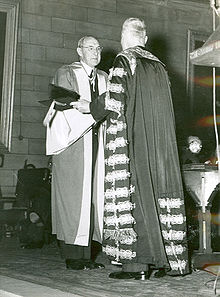Norman Gregg
Sir Norman Gregg Woollahra, Sydney, New South Wales, Australia | |
|---|---|
| Alma mater | University of Sydney |
| Known for | Discovery of congenital rubella syndrome |
| Awards |
|
| Scientific career | |
| Fields | Ophthalmology |
Sir Norman McAlister Gregg,
Early life and education
Gregg was born on 7 March 1892 in
During his education, Gregg was an active and capable sportsman, playing cricket, tennis, baseball, swimming and ice hockey at university. From 1913 to 1914, he represented New South Wales in cricket three times,[3] and once in tennis. Had it not been for the outbreak of World War I, Gregg would have qualified for the Australian Davis Cup team.[2]
Military career
After completing his medical degree, Gregg travelled to
The citation for his MC read:
T./Capt. Norman McAlister Gregg, M.B., R.A.M.C. For conspicuous gallantry and devotion to duty during a raid. He untiringly attended to the wounded under heavy enemy fire until the last man was cleared, and showed great coolness and devotion to duty. He worked persistently throughout the raid in the open, and searched for any wounded that might have been overlooked. He behaved splendidly.[6]
Medical career

Returning to Australia, Gregg was appointed resident medical officer at Sydney's
Gregg returned to Sydney, where he set up a practice in 1923. That same year he was appointed ophthalmic surgeon at RPA, and the same post at the
Congenital rubella syndrome
When World War II began, Gregg was a paediatric ophthalmologist, at a time when most doctors had joined the army and he was one of few eye doctors in Sydney. Gregg noticed a high incidence of congenital cataracts in infants arriving at his surgery – two to three times the normal rate that would be expected from hereditary factors. He overheard a conversation between several mothers whose babies had cataracts, in which they mentioned that they had suffered from German measles (rubella) during pregnancy.[11] Investigating the medical records of children with similar conditions, Gregg discovered that out of 78 affected children, 68 had been exposed to rubella in utero. There had been an outbreak of rubella and meningitis in Australian army camps in 1941, which had been transmitted to the wider community when the men returned to their families.[12]
On 15 October 1941, Gregg delivered a paper, Congenital Cataract following German Measles in the Mother, to the Ophthalmological Society of Australia in Melbourne which published it in its journal, Transactions. Following press coverage of his paper, Gregg was contacted by two mothers who had contracted rubella, and whose children suffered from deafness, and he subsequently issued a further paper detailing Further Observations on Congenital Defects in Infants following Maternal Rubella.[2]
While Gregg's findings were met with praise in Australia, internationally his peers were not so convinced. British medical journal The Lancet wrote that he had failed to adequately prove his case, and it was not until Professor Oliver Lancaster of the University of Sydney proved the association between the rubella virus and congenital syndromes in infants was significant, that his research was accepted around the world.[12]
Gregg was a
Honours
- In 1951, he was awarded the James Cook Medal by the Royal Society of New South Wales, for outstanding contribution to science and human welfare in the Southern Hemisphere.[14]
- On 29 August 1952, he received an honorary degree of Doctor of Science from the University of Sydney[15]
- On 1 January 1953, he was made a Knight Bachelor for services to medical science in the New Year Honours. He received the accolade from the Governor-General of Australia at Government House, Canberra on 28 January 1953.[13][16][17]
- In 1962, Sir Norman was given the Australian Father of the Year award.[18]
- A lecture theatre at the Children's Hospital at Westmead are named after him.[19]
See also
References
- ^ Gregg, Norman McAlister (1892–1966), Bright Sparcs (Australian Science and Technology Heritage Centre, University of Melbourne), 30 June 1997.
- ^ a b c d e f g Paul A. L. Lancaster, Gregg, Sir Norman McAlister (1892–1966), Australian Dictionary of Biography, Volume 14, Melbourne University Press, 1996, pp. 325–327.
- Cricinfo.
- ^ "No. 29177". The London Gazette. 1 June 1915. p. 5211. Lieutenant
- ^ "No. 29542". The London Gazette (Supplement). 7 April 1916. p. 3789. Captain
- ^ a b "No. 30915". The London Gazette (Supplement). 20 September 1918. p. 11296. Military Cross
- ^ "No. 31344". The London Gazette (Supplement). 16 May 1919. pp. 6189–6190. Acting major
- ^ "No. 31826". The London Gazette (Supplement). 16 March 1920. p. 3392. Relinquishment of acting majority
- ^ Dunn, P.M.: Perinatal lessons from the past: Sir Norman Gregg, ChM, MC, of Sydney (1892–1966) and rubella embryopathy, Archives of Disease in Childhood: Fetal and Neonatal Edition, 2007.
- ^ "No. 31815". The London Gazette (Supplement). 5 March 1920. p. 2890. Relinquishment of commission
- ISBN 92-75-11596-6.
- ^ a b Manteuil-Brutlag, Simone: Sir Norman McAllister Gregg Archived 17 September 2006 at the Wayback Machine, Stanford University.
- ^ a b "No. 39734". The London Gazette (Supplement). 30 December 1952. p. 39. Knighthood
- ^ Awards: James Cook Medal Archived 30 August 2007 at the Wayback Machine, Royal Society of New South Wales.
- ^ Advisory Honorary Awards, University of Sydney.
- ^ "No. 39786". The London Gazette. 24 February 1953. p. 1103. Accolade
- ^ GREGG, Norman McAlister, It's an Honour (Australian Government honours database).
- ^ Interview with Sir Norman Gregg, National Library of Australia.
- Royal Alexandra Hospital for Children, 5 May 2005.
External links
- First-class cricket statistics: Norman Gregg (Cricinfo)
